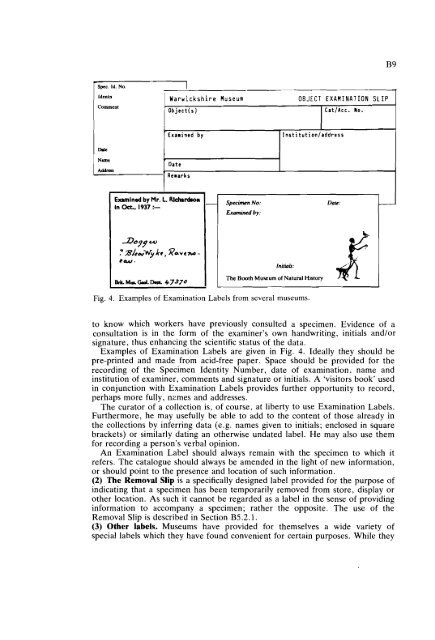GUIDELINES FOR THE CURATION OF GEOLOGICAL MATERIALS
GUIDELINES FOR THE CURATION OF GEOLOGICAL MATERIALS
GUIDELINES FOR THE CURATION OF GEOLOGICAL MATERIALS
You also want an ePaper? Increase the reach of your titles
YUMPU automatically turns print PDFs into web optimized ePapers that Google loves.
ldentn<br />
Comment<br />
Object(s)<br />
OBJECT EXAMINATION SLIP<br />
I<br />
Cat/Acc. No.<br />
- l<br />
I:'<br />
Remarks Date<br />
' Examined by<br />
Institution/address<br />
Exunlnd by Mr. L. Rkhrrdron<br />
Spccimcn No:<br />
Fig. 4. Examples of Examination Labels from several museums.<br />
to know which workers have previously consulted a specimen. Evidence of a<br />
consultation is in the form of the examiner's own handwriting, initials andtor<br />
signature, thus enhancing the scientific status of the data.<br />
Examples of Examination Labels are given in Fig. 4. Ideally they should be<br />
pre-printed and made from acid-free paper. Space should be provided for the<br />
recording of the Specimen Identity Number, date of examination, name and<br />
institution of examiner, comments and signature or initials. A 'visitors book' used<br />
in conjunction with Examination Labels provides further opportunity to record,<br />
perhaps more fully, nemes and addresses.<br />
The curator of a collection is, of course, at liberty to use Examination Labels.<br />
Furthermore, he may usefully be able to add to the content of those already in<br />
the collections by inferring data (e.g. names given to initials; enclosed in square<br />
brackets) or similarly dating an otherwise undated label. He may also use them<br />
for recording a person's verbal opinion.<br />
An Examination Label should always remain with the specimen to which it<br />
refers. The catalogue should always be amended in the light of new information,<br />
or should point to the presence and location of such information.<br />
(2) The Removal Slip is a specifically designed label provided for the purpose of<br />
indicating that a specimen has been temporarily removed from store, display or<br />
other location. As such it cannot be regarded as a label in the sense of providing<br />
information to accompany a specimen; rather the opposite. The use of the<br />
Removal Slip is described in Section B5.2.1.<br />
(3) Other labels. Museums have provided for themselves a wide variety of<br />
special labels which they have found convenient for certain purposes. While they

















